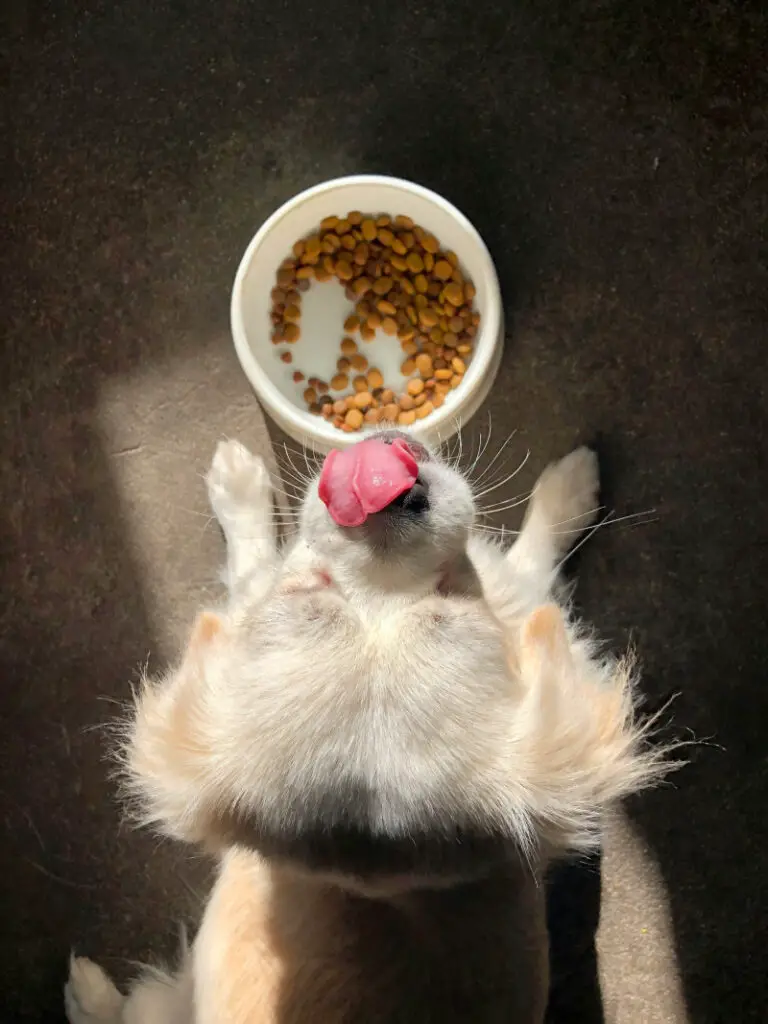Every owner knows that dogs love to eat liver, but just because they really like something doesn’t necessarily mean it’s good for them. Can dogs eat liver? Is liver good for dogs? Should you give your dog liver? If so, what is the right amount and what type of liver is best?
Table of Contents
Is liver good for dogs?
Yes. The liver is not only very appetizing for them but it is also one of the best protein sources to include in the canine diet. Being a viscera, the liver is rich in essential nutrients for the good health and nutrition of your dog. It is high in protein, fatty acids, minerals, and vitamins.
Adding liver to your sweet doggo diet offers many benefits, including:
- High content of vitamin A. Liver is said to be the most abundant source of vitamin A in nature and its most bioavailable form to carnivores. This powerful antioxidant helps promote visual, digestive, and reproductive health.
- Contribution of group B vitamins. They are essential to protect nerve function and prevent anemia in dogs.
- High iron content. Iron is an essential mineral for the transport of oxygen to blood cells, brain function, regulation of body temperature, and metabolism in general.
- A good supply of vitamin D. As in people, vitamin D is crucial in strengthening the canine immune system. It helps prevent infections, and diseases, and promotes muscle and bone strength.
- In addition, the liver is a good source of phosphorus, copper, zinc, magnesium, manganese, calcium, and healthy fats, hence its consumption also supports immunity, good appearance, and health of the skin/coat, as well as strength. of joints and bones.
With this in mind, dogs can and should eat liver as part of their diet. Just be sure to moderate the amount and prepare it correctly.
What is the recommended amount of liver for dogs?
Although liver is considered a safe and healthy food, it can be harmful to dogs if consumed in large quantities. Given its high content of vitamin A, the excess liver in a canine diet can cause hypervitaminosis A or what is the same, an overdose of vitamin A.
According to experts, it is safe to administer small amounts of liver 1 or 2 times a week, always as a complement to the usual diet, not as a substitute for a meal. In addition, it is important to take into consideration the size and weight of the dog, as well as the suggestions of your veterinarian.
In general, it is said that organs/viscera should make up around 5% of the dog’s diet. For a small breed dog, that might mean just 1/5 ounce of liver a day. A medium dog may need about 1 ounce daily, while a very large or giant dog can probably eat a little more, such as 2.5 ounces of liver per day.
Dogs can eat virtually any liver, be it beef, chicken, pork, turkey, or lamb. However, it is not a good idea to let them eat the liver of wild prey, such as ducks, geese, hares, rabbits, and elk. Although complete cooking can make them suitable for consumption by domestic dogs, it is not recommended.
Liver treats
A very popular alternative to the traditional fresh liver is commercial liver treats. Many owners find that these treats make it easy to keep track of how much liver the dog is eating.
In that case, a good recommendation would be to give him no more than 1-2 treats, 2 times a week if he is a small dog; 3-4 treats 2 times a week if he is medium, and 5-6 liver treats if it’s a large breed dog.
Always opt for high-quality products and pay attention to the possible recommendations of the manufacturer.
If your dog is not used to eating liver, start slowly. Being so rich in nutrients, it is warned that it can cause stomach upset or loose stools. Include it in your diet gradually, for example, ½ tablespoon of the liver treat, 2 times a week.
Depending on how your dog’s digestive system reacts, then you can increase the serving size.
How to cook liver for dogs? Forms of consumption + Recipes
Cooking liver for your dog is very easy. The most common cooking method is to saute it in a pan. To do this, chop the liver into fine portions, not very large; Add them to a pan previously greased with olive oil and saute until they have turned completely brown.
Be sure to avoid adding salt, butter, seasonings, or other ingredients not suitable for the pet.
Another very simple form of preparation is boiled or cooked liver. Apply the following steps to cook chicken liver, beef liver, or any other type of liver you have at home.
- Take the liver out of the packaging. If it is the frozen liver, the first step will be to thaw it.
- Then rinse it off with cold water. This will help remove any remnants of wrapping or any dirt.
- Add the liver to a pot of water to bring to a boil. There should be enough water to cover the liver pieces.
- When the water has started to boil, reduce the heat to low and cook for another 15 minutes.
- Once tender, remove the liver from the pot and place it on a plate. Let it cool before cutting it into small pieces to give to your dog.
Note. The cooking process of the liver usually causes the partial loss of some nutrients, including iron, vitamin A, magnesium, phosphorus, and the B vitamins.
Ideas for a dog to eat liver
Can dogs eat liver:
- Sauteed or cooked (companion in meals)
- Dehydrated as cecina (snacks, reward)
- In the form of a homemade treat (reward)
- In the form of homemade pate (complement of meals, companion for sweets)
Easy recipe: Homemade liver treats for dogs
This homemade liver treat for dogs is perfect to use as a reward during training.
Ingredients
- 1 cup of chicken or beef liver
- 2 cups of oatmeal (if you don’t have the flour, you can pulverize the oatmeal in the food processor)
- 2 whole eggs
- 2 tablespoons coconut oil
Instructions
- Preheat the oven to 190ºC (375ºF).
- In a food processor, puree the liver until you get a paste.
- Add the flour and pulse until combined with the liver.
- Incorporate the eggs and also process them together with the previous dough.
- Remove the dough and spread it evenly on a clean surface.
- Once flattened, cut small pieces out of the liver dough with cookie cutters, or simply cut small rectangles with a knife.
- Place the treats on a baking sheet (lined with parchment paper) and bake for 20 minutes or until fully cooked.
- Keep these tasty liver treats in the refrigerator and use them within a week.
Raw or cooked liver for dogs?
A very common question is whether dogs can eat raw liver, and the short answer to this question is: yes. Dogs can eat both raw and cooked liver. In fact, many believe that raw liver is the best alternative since it preserves all its nutrients intact.
However, it is not recommended to feed a dog raw liver if it does not come from a reliable, totally safe source. It is also not advisable for them to eat the raw liver of wild prey. There is a risk that it contains harmful bacteria such as Salmonella and Campylobacter.
Some owners prefer that the dog only eat lightly cooked liver because they consider it a safer form of consumption for their health.
Contraindications and warnings about the consumption of liver in dogs
It is normal to wonder if the liver is really a safe food for dogs. Many people fear that, due to the role of the liver in the body, its consumption could bring risks to the health of the pet.
First of all, it should be clarified that although the liver fulfills the important function of filtering toxins in the body, it does not store them. That means that it is not a type of meat that is toxic for dogs. In fact, some lean cuts of meat can contain higher concentrations of toxins than the liver.
Now, it is very important not to exceed the amount of liver recommended in the canine diet. Its excessive intake can bring negative consequences linked to the high concentration of some minerals and vitamins.
Hypervitaminosis A
Vitamin A is essential for both humans and dogs and cats. Its deficiency can cause serious long-term problems. However, taking too much vitamin A can also be harmful, leading to serious toxicity.
A dog that eats a lot of liver on a regular basis is at risk of developing hypervitaminosis A. This condition causes decalcification of bones and teeth, joint stiffness and immobility, paralysis, seizures, and kidney damage.
Copper excess toxicity
Since the liver is a food rich in copper, its consumption can cause toxicity in some dogs, especially in breeds that do not metabolize this mineral very well. This includes the Bedlington Terrier, Doberman Pinscher, West Highland White Terrier, Skye Terrier, Dalmatian, and Labrador Retriever.
Excessive copper toxicity affects the proper functioning of the liver and causes different symptoms, such as weight loss, reduced appetite, frequent urination, intermittent diarrhea, and vomiting.
See: Why Does My Dog Have Diarrhea and Vomiting? What I can do?
Stone formation
Regular liver consumption may be contraindicated in dogs with uric acid kidney stones. This is because the liver is high in purines, compounds whose digestion generates uric acid as a waste by-product. Dalmatian dogs are said to be especially susceptible to developing this type of stone.
Quick Answers to Frequently Asked Questions
What type of liver is best for dogs?
The most recommended livers for dogs are chicken, beef, veal, and pork livers. Turkey and lamb are also good options. It is best to always opt for liver from farm animals, avoiding giving liver from wild animals, such as ducks, elk, and rabbits.
Which is more nutritious, chicken or beef liver?
Both types of the liver are excellent for our dogs, but as expected, there are some differences in terms of nutritional content. Beef liver contains more magnesium, phosphorus, zinc, copper, manganese, calcium, and iron. However, chicken liver contains more selenium, niacin (vitamin B3), thiamin (vitamin B1), beta-carotene, vitamin C, and vitamin D.
In addition, the chicken liver has approximately 30% more total fat than beef liver.



